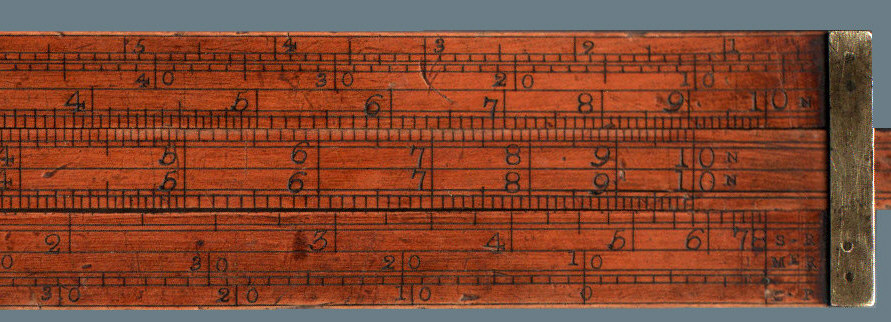1. This slide rule was used for navigation at sea.
2. This rule is the same as one on the British Science Museum web site, as far as can be told from their not very large photo. There it is described as:
"A 2 foot boxwood slide rule for navigators, c.1800. 'Sliding Gunters' , or navigator's rules with a slide are comparatively rare, as most navigators preferred to stick with the ordinary 'Gunter' scale based on the combination of trigonometric, logarithmic and surveying lines suggested by Edmund Gunter in the 1630s."
Even this side rule makes provision for some calculations to be done by dividers.
The museum's rule is dated to 1780 to 1800.
4. The detail of the front right of the rule shows the following:
- A scale marked TAN. Under it, to the right is a scale marked SIN; the
values of sine for the angles on the SIN scale are the same as the values of
TAN for the angles on the TAN scale. For example, tan (30°)
= 0.577 and sin-1 (0.577)= 35.4° ,
which is the
angle on the SIN scale opposite the 30 on the TAN scale. To the left of the
SIN scale is a scale marked SEC (n.b. secant = 1/cosine). This has the
equivalent pair of values of angles for which the values of TAN and SEC are
equal. Note the degrees are divided with 6 units to facilitate the use of
degrees and minutes.
- Two scales marked SIN, one on the stock and one one the slide. On the
opposite face of the rule is a scale of numbers. The value of the number
corresponds to the sine of the angle marked.
- Two scales marked TAN, one on the stock and one the slide. As with the SIN
scale, values of TAN are on the scale of numbers on the opposite face.
- A pair of adjacent scales marked SIN and V.SIN.
In navigation use is sometimes made of Versines (or Versed sine), such that Versine (q)
= 2 sin2(q/2), or Haversine such that
Haversine (q) =sin2(q/2).
The pairs of values of this scale are arranged such that the sine of the
angles marked SIN have the same values as 1 - Haversine. For example:
Haversine (90°) = sin2(45°)
= 0.7072 .
1 - 0.7072 = 0.5
sin-1(0.5) = 30°.
As can be seen the 90° on the V.SIN
line is adjacent the 30° on the SIN line
5. Traditionally a compass was divided in Rhumbs. The four points (North, South, East and West) were first divided into two, NE for example, giving eight values. These were further divided into two, NNE for example, giving 16 values. These were yet against divided into two, North by NNE for example, giving 32 values or Rhumbs. This Scale which goes 0 to 8 Rhumb values against 90° of what is know as the chord scale.
6. In centre top of the front face there is a scale of Miles of Longitude. At the equator, 0°, there are 60 nautical miles per degree of longitude. At the pole, 90° , there are zero nautical miles per degree of longitude.
7. In the left top of the front face there is scale marked LEA, for leagues. this line is also known as a line of equal parts. A similar line, marked RUM, is provided for Rhumbs. These lines are intended for use with compasses or dividers (as was the case with Gunter's scales). Note that the upper scale has 10 equal divisions to the left of what is effectively the 0 and also that here, as at other points on the rule, there is a bass pin with an indented centre for compasses.
8. The detail of the right rear face of the rule shows:
- On the top of the rule are two scales for measuring. One in inches and the
other in 100ths of a foot.
- The three scales of number, marked NUM, corresponding to the sin and tan
scales on the front face.
- A scale marked S-R, which gives sines of Rhumb values. For example 3
rhumbs is equivalent to 33.75°
. The sine of 33.75° is 0.555. (on
the image below the slide is not aligned for this calculation).
- A pair of scales which are the equivalent of a Table of Meridianal
Parts; equivalent scales are also found on Gunter's scales. (See
here for a Gunter scale) . These are used for calculating the differences
of meridian between two locations on the surface of the earth.
My thanks to Otto van Poelje for comments on this web page. He has a list on known rules such as this at:
http://www.oughtred.org/jos/vanpoelje-sliding-gunter.xls
As can be seen from that table there are less than 30 such rules in museums and private collections of which the 24" size with the scale arrangement on this one is the most common. Otto has also published article on navigation rules (slide Gunters) in the Journal of the Oughtred Society.)



Scale of Rum and Chord



